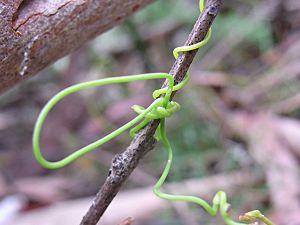Slender devil's twine facts for kids
Quick facts for kids Slender devil's twine |
|
|---|---|
 |
|
| on a Blackbutt twig, Chatswood West, Australia | |
| Scientific classification | |
| Genus: |
Cassytha
|
| Species: |
glabella
|
Cassytha glabella, also known as the slender devil's twine, is a unique plant found in many damp areas of Australia. It belongs to the Laurel family, just like the trees that give us bay leaves. This plant is a special kind of climber because it's a hemi-parasite. This means it gets some of its food and water from other plants, but it can also make some of its own.
The name glabella comes from Latin and means "smooth" or "hairless". This describes the plant well, as it doesn't have hairs like some of its relatives. Its small fruits are known to be sweet and a bit sticky. Other similar plants, like the Devil's Twine (Cassytha pubescens) and Cassytha melantha, have thicker or hairier stems.
Discovery and Names
This interesting plant was first described in science in 1810. A famous Scottish botanist named Robert Brown wrote about it in his book, Prodromus Florae Novae Hollandiae.
Besides "slender devil's twine," people sometimes call it Smooth Cassytha, slender dodder-laurel, or tangled dodder-laurel. Cassytha glabella and other plants in the Cassytha group are sometimes placed in their own family, Cassythaceae. However, they are usually considered part of the larger Laurel family (Lauraceae).
What it Looks Like
The slender devil's twine is a small vine that twists and turns. Its stems are very thin, usually about half a millimeter wide. It has tiny parts called haustoria that are less than one millimeter long. These are like tiny suckers it uses to attach to other plants.
Instead of regular leaves, this plant has very small scales. You might not even notice them!
Flowers and Fruit
You can find the tiny flowers of Cassytha glabella at any time of the year. However, they are most common from November to March in places like the Sydney area. The flowers grow on a short spike, about 5 to 7 millimeters long. They don't have stalks and are usually yellow or white.
The fruit of this plant is round and can be green or yellow. Sometimes it has red spots. It's smooth and juicy, usually about 3 to 6 millimeters wide.
Life Cycle
The life of Cassytha glabella starts when a seed sprouts in the ground. A small vine grows from the seed and reaches out, looking for other plants. Once it finds a plant, it latches on. After it has attached itself, the original root from the seed dies. From then on, the plant gets all its water and nutrients by attaching to the stems and branches of other plants.
Even though it looks a bit like plants from the Cuscuta genus, which are also parasitic, Cassytha glabella is not related to them. It's a unique plant with its own special way of living!

